|
By
virtue of having no moving parts our acousto-optic modulators (AOMs) are
able to amplitude modulate a laser beam at very high speed. For example
modulation bandwidths in excess of 50MHz are readily achievable.
In
an AOM a laser beam is caused to interact with a high frequency
ultrasonic sound wave inside an optically polished block of crystal or
glass (the interaction medium). By carefully orientating the laser with
respect to the sound waves the beam can be made to reflect off the
acoustic wavefronts (Bragg diffraction). Therefore, when the sound field
is present the beam is deflected and when it is absent the beam passes
through undeviated. By switching the sound field on and off very rapidly
the deflected beam appears and disappears in response (digital
modulation). By varying the amplitude of the acoustic waves the
intensity of the deflected beam can similarly be modulated (analogue
modulation).
It
is usual to choose the deflected beam as the one that is used in the
optical system because it can be switched on and off with high
extinction ratio (typically >40dB) and intensity can be varied from
zero to more that 85% of the incident beam. The rate at which the beam
can be modulated is governed by the time it takes the acoustic
wavefronts to traverse the laser beam, which depends on the beam
diameter and the acoustic velocity in the interaction medium.
The
sound waves are generated by a transducer, usually a thin wafer of
lithium niobate, that is bonded onto the interaction medium using a
highly efficient cold-weld metallic bonding process. When a high
frequency electrical signal is applied to the transducer it vibrates,
generating the acoustic wave. The signal is derived from an RF driver,
which generates a high frequency carrier that is itself modulated by an
analogue or digital input signal.
Principal
applications for AO modulators are pre-press (putting image and text
data onto films or plates as part of the printing process), laser
imaging and displays, switching in telecom fibres, instrumentation and
research.


AOM
Schematic Fiber-coupled AOM Schematic
1.
Free-space Acousto-optical Modulators
We
offer a wide range of standard AO Modulators, for digital or analogue
intensity modulation of laser beams.
Their main specifications are as follows:
-
Wavelength
Range: 240nm to 2100nm
-
Drive
Frequencies: 20MHz to 350MHz
-
Optical
Rise-Times: Down to 5ns
-
Modulation
Bandwidths: Up to 100MHz
-
Interaction
Materials: Tellurium Dioxide, Lead Molybdate, Fused Silica, Crystal Quartz,
Chalcogenide
Glass, Flint Glass.
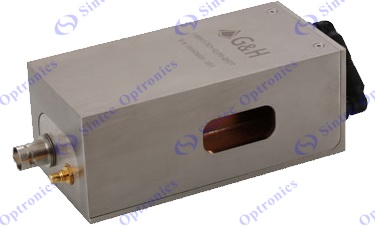 An
RF
Driver provides
the electronic signal operating the AO Modulator. With a digital driver,
an external TTL signal enables rapid on and off switching of the optical
beam. Alternatively an anologue driver enables a variable intensity
output, typically from 0% to 85% of the input beam. An
RF
Driver provides
the electronic signal operating the AO Modulator. With a digital driver,
an external TTL signal enables rapid on and off switching of the optical
beam. Alternatively an anologue driver enables a variable intensity
output, typically from 0% to 85% of the input beam.
The
maximum modulation bandwidth, or optical rise-time, is a function of the
acoustic transit time across the optical beam. Therefore, for the
highest speeds it is often necessary to focus the optical beam down to a
small spot inside the modulator.
Our
standard AOMs are listed below:
| Model |
Type |
Wavelength |
Rise/ Fall time |
Active Aperture |
Operating
Frequency |
Optical Material |
| I-M110-4C19R19-3-GH93 |
UV |
193-266nm |
110ns/mm |
4mm |
110MHz
|
ArF grade fused
Silica |
| AOMO 3200-1220 |
UV |
257nm
|
10ns |
0.25mm
|
200MHz
|
Crystalline
Quartz |
| I-M110-3C10BB-3-GH27 |
UV |
300-400nm |
113ns/mm |
3mm |
110MHz
|
Crystalline
Quartz |
| I-M110-3C10T-3-GH72 |
UV |
355nm
|
113ns/mm |
3mm |
110MHz
|
Crystalline
Quartz |
| I-M80-6.5C10T-4-GH60 |
UV
|
355
nm |
113ns/mm |
6.5mm
|
80
MHz |
Crystalline quartz |
| I-M110-2C10B6-3-GH26 |
UV |
400-540nm |
113ns/mm |
2 mm |
110 MHz
|
Crystalline
quartz |
| AOMO 3200-121 |
Visible
|
442-488nm |
153ns/mm |
0.32nm
|
200MHz
|
Tellurium Dioxide |
| AOMO 3200-120 |
Visible
|
442-488nm |
153ns/mm |
0.45mm
|
200MHz
|
Tellurium Dioxide |
| AOMO 3110-121 |
Visible
|
442-488nm |
153ns/mm |
0.6mm
|
110MHz
|
Tellurium Dioxide |
| AOMO 3080-125 |
Visible
|
415-900nm |
153ns/mm |
2mm |
80MHz
|
Tellurium Dioxide |
| AOMO 3100-125 |
Visible
|
440-850nm |
153ns/mm |
1.5mm
|
100MHz
|
Tellurium Dioxide |
| AOMO 3200-125 |
Visible
|
440-850nm |
153ns/mm |
1.5mm |
200MHz
|
Tellurium Dioxide |
| AOMO 3350-125 |
Visible
|
440-850nm |
153ns/mm |
1.5mm |
350MHz
|
Tellurium Dioxide |
| AOMO 3110-120 |
Visible
|
440-850nm |
153ns/mm |
0.6mm
|
110MHz
|
Tellurium Dioxide |
| AOMO 3080-120 |
Visible
|
440-850nm |
153ns/mm |
1mm |
80MHz
|
Tellurium Dioxide |
| AOMO 3350-120 |
Visible
|
488-532nm |
153ns/mm |
0.1mm |
350MHz
|
Tellurium Dioxide |
| I-M080-2C10B11-4-GH95 |
IR |
700-1000nm |
113ns/mm |
2 mm |
80MHz
|
Crystalline
quartz |
| AOMO 3200-124 |
IR |
780- 850nm
|
113ns/mm
|
0.32mm
|
200MHz |
Tellurium Dioxide |
| AOMO 3080-122 |
IR |
780-850nm |
153ns/mm |
1mm |
80MHz
|
Tellurium Dioxide |
| AOMO 3200-1113 |
IR |
870-1250nm |
153ns/mm |
0.1mm
|
200MHz
|
Tellurium Dioxide |
| I-M080-2C10G-4-AM3 |
IR |
1030-1064nm |
113ns/mm |
2mm |
80MHz
|
Crystalline
Quartz |
| I-M080-4C10G-4-GH60 |
IR |
1030-1064 nm |
113ns/mm |
4 mm |
80MHz
|
Crystalline
quartz |
| I-M068-5C10G-U5-GH100 |
IR |
1030-1064 nm |
113ns/mm |
5 mm |
68MHz
|
Crystalline
quartz |
| AOMO 3110-197 |
IR |
1030-1090nm |
153ns/mm |
1.25mm
|
110MHz
|
Tellurium Dioxide |
| AOMO 3080-194 |
IR |
1060nm
|
153ns/mm |
1.75mm
|
80MHz
|
Tellurium dioxide |
| AOMO/AOFS 3165-1 |
|
1300-1550 nm |
153ns/mm |
0.6mm
|
165MHz
|
Tellurium dioxide |
| I-M040-2C8J-3-GH84 |
|
1550 nm
|
260ns/mm |
2mm |
40MHz
|
AMTIR |
| I-M041-3C2V5-4-IS8 |
|
2000 nm
|
153ns/mm |
3mm |
40.68MHz
|
Tellurium dioxide |
| I-M041-1.4C10V5-4-GH49 |
|
1900-2100 nm |
113ns/mm |
1.4 mm
|
40.68 MHz |
Crystalline
quartz |
| I-M040-2C8B1-3-GH84 |
|
1900-2100 nm |
260ns/mm |
2mm |
40MHz
|
AMTIR |
| I-M050-10C11V49-P5-GH77 |
|
5.5 μm
|
120ns/mm |
7.0, 9.6mm |
50 MHz
|
Germanium |
| I-M050-10C11V41-P3-GH75 |
|
9.4 μm
|
120ns/mm |
9.6 mm
|
40/60 MHz
|
Germanium |
| I-M041-xxC11xxx-P5-GH77 |
|
9.4/10.6μm |
120ns/mm |
7.0, 9.6mm |
40.68 MHz
|
Germanium |
For old AOM product please refer
Here!
2.
STBR series free space AOM
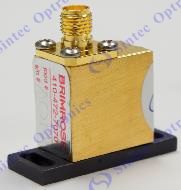
The STBR series free space Acousto-Optic Modulator (AOM) with RF driver
is used to vary and control laser beam intensity. It is electronically
programmable using a microprocessor connected to the Brimrose RF driver
unit. The RF driver features all the necessary components to drive the
modulator with analog or digital input control. Our free space AO
products are housed in environmentally stable packages. They offer
superior resistance to humidity and temperature, and are suitable for
laboratory as well as various OEM applications and instrumentations.
| Model # |
Spectral Range (nm) |
Rise Time (ns) |
Active Aperture (mm) |
Modulation Bandwidth (MHz) |
DE (%) |
| TEM-85-2 |
380-1600
|
280
|
2.0
|
2
|
80 |
| TEM-85-10 |
380-1600
|
55
|
1.0
|
10
|
80 |
| TEM-110-25 |
380-1600
|
22
|
0.5
|
25
|
80 |
| TEM-200-50 |
380-1600
|
10
|
0.3
|
50
|
70 |
| TEM-400-100 |
380-1600
|
5.5
|
0.075
|
100
|
50 |
| TEM-800-200 |
380-1600
|
3
|
0.05
|
200
|
35 |
| AMM-27-2 |
1000-2500
|
300
|
1
|
1.8
|
>80 |
| AMM-80-4 |
1000-2500
|
160
|
1
|
4
|
>80 |
| AMM-100-8 |
1000-2500
|
68
|
0.3
|
8
|
>80 |
| FQM-80-2 |
200-1300
|
195
|
1.6
|
2.8
|
70 |
| FQM-80-20 |
200-1300
|
30
|
1
|
18
|
70 |
| FQM-200-40 |
200-1300
|
14
|
0.3
|
40
|
70 |
| GEM-40-4 |
2000-11,000
|
125
|
1.5
|
5
|
70 |
| GPM-200-50 |
600-1600
|
11
|
0.3
|
50
|
>75 |
| GPM-400-100 |
600-1600
|
5.1
|
0.1
|
108
|
>65 |
| GPM-800-200 |
600-1600
|
2.6
|
0.05
|
217
|
>40 |
| GPM-1600-400 |
600-1600
|
1.4
|
0.025
|
400
|
>25 |
| IPM-200-26 |
1000-1600
|
21
|
0.3
|
26
|
60 |
| IPM-400-100 |
1000-1600
|
5
|
0.075
|
100
|
50 |
3.
Fiber-coupled
Acousto-optical Modulators
(AOM)
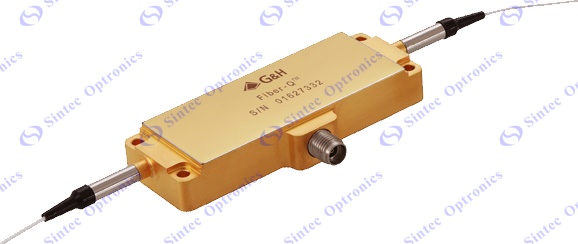
Our
standard fibre-coupled AOMs are listed below. If you would like to see a
detailed technical data sheet just click on the relevant model number.
If you do not see a device that meets your requirements please contact
one of our engineers. We manufacture application-specific AOMs and would
be pleased to design one that meets your needs.
The devices listed are aimed at fibre-optic telecommunications
applications but we can also offer fibre-coupled versions of our
standard AOMs, if required. If you are considering a non-standard
device, or are just not sure which of the listed devices would suit you
best, you may find it useful to email
us with your questions.
Our standard FCAOMs are listed below
| Model |
Description |
Optical Power |
Wavelength |
Rise/Fall time |
Operating Frequency |
Driver |
| S200-0.4C2N-3-F2P |
Non-hermetic, PM |
|
450,
532,
633,
780 nm |
25 ns |
200 MHz |
1xxxAFAINA-
3.0 HCR
1xxxAFDINA-
3.0 HCR
|
| T-M150-0.5C2W-3-F2S |
Non-hermetic, SM |
|
780 nm |
30 ns |
150 MHz |
| T-M150-0.5C2W-3-F2P |
Non-hermetic, PM |
|
780 nm
|
30 ns |
150 MHz |
| T-M150-0.4C2G-3-F2S |
Hermetic, |
5W average |
1060nm |
30ns |
150MHz |
| T-M200-0.1C2G-3-F2S |
Hermetic, SM, |
1W average |
1060nm |
10ns |
200MHz |
| T-M200-0.1C2G-3-F2P |
Hermetic, PM, |
1W average |
1060nm |
10ns |
200MHz |
| S-M150-0.4C2G-3-F2S |
Non-hermetic, SM, HI1060 |
|
1060nm |
30 ns |
150 MHz |
| T-M260-0.1C2G-3-F2P |
Hermetic, PM |
|
1060nm |
6 ns |
260 MHz |
| T-M200-0.1C2G-3-F2P |
Hermetic PM |
|
1060nm |
10 ns |
200 MHz |
| T-M200-0.1C2G-3-F2S |
Hermetic SM HI1060 1W average |
|
1060nm |
10ns |
200MHz |
| T-M150-0.4C2G-3-F2P |
Hermetic, Fujikura PM980
(SM98-PS-U25A) |
5W average |
1060nm |
30ns |
150MHz |
| T-M200-0.1C2J-3-F2P |
Hermetic, Fujikura PM1550
(SM15-PS-U25A) |
1W average |
1550nm |
10ns |
200MHz |
| T-M200-0.1C2J-3-F2S |
Hermetic, SMF28 |
1W average |
1550nm |
10ns |
200MHz |
| T-M110-0.2C2J-3-F2S |
Hermetic, SMF28 |
1W average |
1550nm |
25ns |
110MHz |
| T-M110-0.2C2J-3-F2P |
Hermetic, Fujikura PM1550
(SM15-PS-U25A) |
1W average |
1550nm |
25ns |
110MHz |
| T-M080-0.4C2J-3-F2S |
Hermetic, SMF28 |
1W average |
1550nm |
35ns |
80MHz |
| T-M080-0.4C2J-3-F2S |
Hermetic, PM |
1W average |
1550nm |
35ns |
80MHz |
| T-M080-0.4C2J-3-F2P |
Hermetic, Fujikura PM1550
(SM15-PS-U25A) |
1W average |
1550nm |
35ns |
80MHz |
| T-M040-0.5C8J-3-F2S |
SMF28 |
1W average |
1550nm |
70-100ns |
40MHz |
| T-M080-0.5C8J-3-F2S |
Hermetic, Low power
consumption |
1W average |
1550nm |
70-100ns |
80MHz |
| T-M080-0.5C8J-3-F2P |
Hermetic, Polarisation
Maintaining, Low power
consumption |
1W average |
1550nm |
70-100ns |
80MHz |
| T-M040-0.5C8J-3-F2P |
Polarisation Maintaining, |
1W average |
1550nm |
70-100ns |
40MHz |
| T-M080-0.3C2Z-3-F2S |
Nufern SM1950 |
5W average |
2000nm |
70-100ns |
80MHz |
| T-M080-0.3C2Z-3-F2P |
Nufern PM1950 |
5W average |
2000nm |
70-100ns |
80MHz |
For old FCAOM product please refer
Here!
4.
STBR Series Fiber Coupled AOM
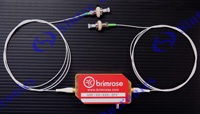
General Specification
| Switching time (nsec)
|
<100 |
| ON/OFF Extinction
(dB) |
>50 |
| Back Reflection (dB)
|
<-50 |
| Insertion Loss (dB)
|
< 2.5 |
| Wavelengths (nm)
|
380-2100nm |
| Low Electric Power
Consumption (dBm) |
<23 |
| Operating Wavelength
Range (nm) |
>60 |
| Model # |
Wavelength (nm) |
Center Frequency (MHz) |
Rise
Time (ns) |
Modulation
Bandwidth (MHz) |
Fiber
Type |
|
STBR-TEM-110-10-55-2FP |
380-1600 |
110
|
55
|
10 |
SM or PM |
|
STBR-TEM-200-25-20-2FP |
380-1600 |
200 |
20 |
25 |
|
STBR-TEM-250-50-10-2FP |
380-1600 |
250
|
10
|
50 |
|
STBR-TEM-500-100-5-2FP |
380-1600 |
500
|
5
|
100 |
|
STBR-IPM-200-25-20-2FP |
1000-2100 |
200
|
20
|
25 |
|
STBR-IPM-500-100-5-2FP |
1000-2100 |
500
|
5
|
100 |
|
STBR-AMM-100-20-25-2FP |
1000-2500 |
100
|
25
|
20 |
| STBR-AMM-55-8-70-2FP
|
1000-2500 |
55
|
70
|
8 |
5.
Multi-channel Modulators
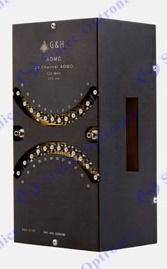 Acousto-optic
multi-channel modulators (AOMC) allow multiple beams to be modulated or
deflected independently by integrating an array of transducers with a
single acousto-optic crystal. Our proprietary optical and electrical
designs minimize crosstalk, allowing concurrent operation of up to 48
channels for modulation, and up to 8 channels for beam deflection. Our
AOMCs are known for their reliable operation and high performance. Acousto-optic
multi-channel modulators (AOMC) allow multiple beams to be modulated or
deflected independently by integrating an array of transducers with a
single acousto-optic crystal. Our proprietary optical and electrical
designs minimize crosstalk, allowing concurrent operation of up to 48
channels for modulation, and up to 8 channels for beam deflection. Our
AOMCs are known for their reliable operation and high performance.
Multi-channel modulators have parallel beams as input, each beam
independently controlled by a different transducer to modulate its
intensity. Multi-channel modulators are most often used for high speed
applications like micromachining and direct-write lithography, as each
beam can be modulated independently.
These devices can also be used to increase throughput when writing large
media by writing multiple beams at the same time. Our multi-channel
modulators equal the performance available with our single channel
modulators, and can be customized for large aperture applications as
well as high speed, small aperture applications.
A multi-channel beam deflector however, generates multiple diffracted
beams from a single input beam at specific locations by simultaneously
applying multiple frequencies to a single transducer. Each individual
channel is a deflector that can either scan the beam or produce multiple
spots. This makes it possible to create a two dimensional grid. For
example, if a four channel beam deflector were configured so that each
channel diffracted three spots, the result would be a 4x3 grid.
High laser damage threshold is achieved using low-scatter materials.
These are inspected to rigorous quality standards. We grow our own
tellurium dioxide and source high quality fused silica and crystalline
quartz to ensure low insertion loss and excellent optical power
handling.
Our standard model are listed below:
| Model |
Wavelength
|
No.
of Channels |
Rise/Fall
Time |
Active
Aperture |
Operating
Frequency |
Optical Material |
| AOMC 220-4 z |
350-365 nm
|
4 |
16 ns
|
0.24 mm
|
190-250 MHz
|
Crystalline quart |
| AOMC 125/24-3 |
350-365 nm
|
24 |
23 ns
|
0.5 mm
|
125 MHz
|
Crystalline
quartz |
| AOMC 3160-8 |
364 nm
|
8 |
21 ns
|
0.18 mm
|
160 MHz
|
Fused silica |
| AOMC 300-5 |
413 nm
|
5 |
10 ns
|
0.2 mm
|
300 MHz
|
Crystalline
quartz |
| AOMC 220-5 |
413 nm
|
5 |
16 ns
|
0.24 mm
|
220 MHz
|
Crystalline
quartz |
| AOMC 3350-6 |
350-850 nm
|
6 |
30 ns
|
0.33 mm
|
350 MHz
|
Tellurium dioxide |
Fiber
coupled AOM (AOMR series)
 
|
Part Number |
AOMR-80 |
AOMR-120 |
|
Interactive Material |
TeO2 |
TeO2 |
|
Acoustic Mode |
Longitudinal |
Longitudinal |
|
Operating Wavelength |
1064nm |
1064nm |
|
Operating Frequency |
80MHz |
120MHz |
|
Fiber Type |
Single mode Hi 1060, 0.5m long |
Single mode 10/125, 0.5m long |
|
Insertion Loss |
<2.0dB |
<2.0dB |
|
On/off Contrast Ratio |
>40dB |
>40dB |
|
Throughout Laser Power |
>3W
CW (>5kW pulsed) |
>3W
CW (>5kW pulsed) |
|
Light Polarization |
Random |
Random |
|
RF
Power Level |
>1.5W |
>2W |
|
Impedance |
50
Ohm |
50
Ohm |
|
VSWR |
<1.2:1@ 80MHz |
<1.2:1@ 120MHz |
|
Mechanical Dimensions |
142mm�44mm�37mm |
139mm�56.5mm�25.5mm |
|
RF
Driver |
AOMD-80-1.5 |
AOMR-120-2 |
RF Driver for AOMR series
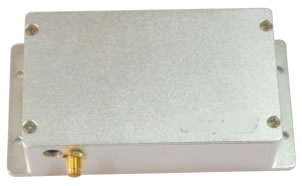
|
Model |
AOMD-80-1.5 |
AOMR-120-2 |
|
AOM |
AOMR-80 |
AOMR-120 |
|
Output Frequency |
80.000 MHz + 0.01% Quartz Stabilized |
120.000 MHz + 0.01% Quartz Stabilized |
|
Spurious Levels |
-50
dBc Maximum |
-50
dBc Maximum |
|
Harmonic Distortion |
-15
dBc Maximum |
-15
dBc Maximum |
|
Modulation Input |
TTL,
High Level: Full RF Power, Low Level: Minimum RF Power |
TTL,
High Level: Full RF Power, Low Level: Minimum RF Power |
|
Extinction Ratio |
50
dB Minimum |
50
dB Minimum |
|
RF
Rise |
200ns Maximum, PRF: 10 to 90 % |
200ns Maximum, PRF: 10 to 90 % |
|
Fall Time |
20
ns Maximum, PRF: 90 to 10 % |
20
ns Maximum, PRF: 90 to 10 % |
|
RF
Output Powe |
>1.5 Watts, Factory Set for Optimum Performance |
>2
Watts, Factory Set for Optimum Performance |
|
Output Impedance |
50
Ohms Nominal |
50
Ohms Nominal |
|
Supply Voltage |
+
24 VDC�0.5 Volt |
+
24 VDC�0.5
Volt |
|
Supply Current |
1
Amp Maximum |
1.5
Amp Maximum |
|
Mechanical Dimensions |
114mm�58mm�30mm |
114mm�58mm�30mm |
|
MAXIMUM RATINGS: |
|
Supply Voltage |
+
28 Volts |
+
28 Volts |
|
Power Output |
No
DC Feedback Allowed |
No
DC Feedback Allowed |
|
Case Temperature* |
+
55�C |
+
55�C |
|
*The
Driver Must Be Attached to an Adequate Heatsink.
|
|
CONNECTORS & MECHANICAL: |
|
RF
Output Connector |
SMA
Female |
SMA
Female |
|
Modulation Input connector |
Wire |
Wire |
|
Power Supply connections |
Wire |
Wire |
Fiber
coupled AOM (AOMM series)
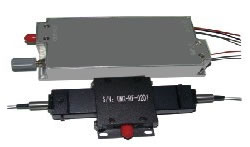
Specifications:
|
Parameters |
Unit |
AOMM-①-②-③-④-⑤ |
|
Central wavelength |
nm |
1064 |
1550 |
2000 |
|
Wavelength range |
nm |
�5 |
�5 |
�5 |
|
Typ.
Insertion loss |
dB |
1.2 |
2.0 |
2.0 |
|
Max
insertion loss |
dB |
1.5 |
3.0 |
3.0 |
|
Min
isolation |
dB |
50 |
50 |
50 |
|
Min
return loss |
dB |
50 |
50 |
50 |
|
Optical power CW |
W |
2 |
5 |
10 |
|
Min
polarization extinction ratio |
dB |
20
(PM fiber) |
20
(PM fiber) |
20
(PM fiber) |
|
Peak power |
kW |
10 |
10 |
10 |
|
RF
power |
W |
2 |
2 |
2 |
|
RF
frequency |
MHz |
35/40/60/80/100/120/150/200 |
|
VSWR |
MHz |
<1.2:1 (50ohm) |
|
Tensile load |
N |
5 |
|
Fiber type |
/ |
9/125, 10/125, 15/130, 20/130 or others |
|
Fiber length |
m |
1 |
|
Operating temperature |
�C |
5-50 |
Ordering
code:
AOMM-
①-
②-
③-④-⑤
①:
Wavelength in nm, 1064, 1550, 2000
②:
Frequency in MHz, 35, 40, 60, 80, 100, 120, 150, 200
③:
Fiber type, L06-6/125, L09-9/125, L10-10/125 DCF, L12-12/125 DCF,
P06-PM98, P09-PM1550, P10-PM10/125 DCF, S-Specify
④:
Fiber jacket on In&Out, B-Bare fiber, L-900um loose fiber, C-3mm loose
fiber, S-Specify
⑤:
Fiber length: 10-1.0m
Dimensions:

 More AOMs
AO Q-switch
More AOMs
AO Q-switch |
